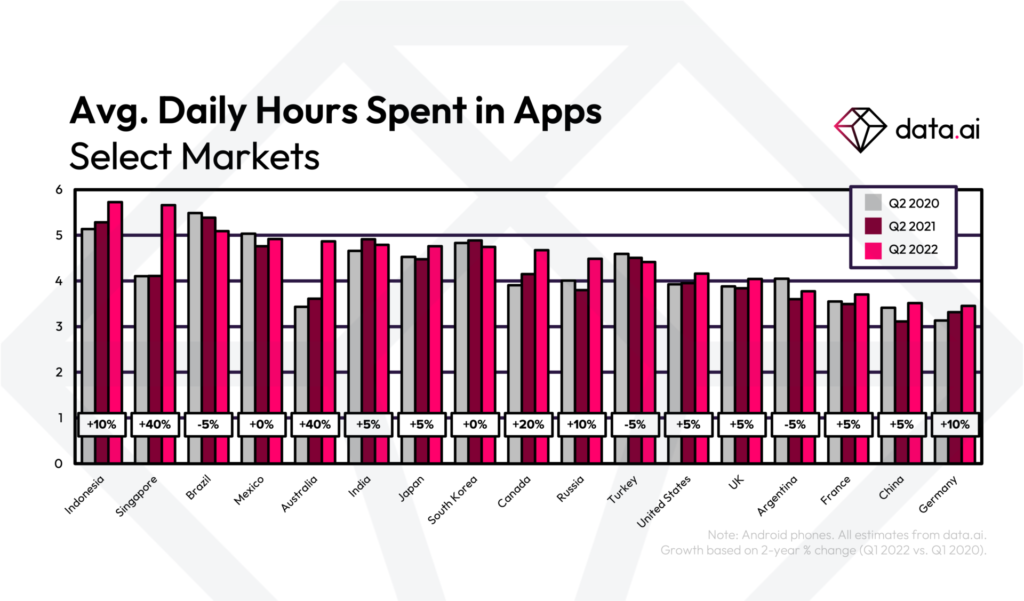
Newsletter
Newsletter
In this week’s bulletin, we review data.ai’s research that finds that mobile use is still growing after pandemic re-openings around the world. How can publishers benefit?
10th August 2022

In Pugpig’s weekly media bulletin, Pugpig’s Kevin Anderson – who has a background as a senior editorial leader for newspapers and broadcasters, a digital media consultant and a digital product director – distills some of the best strategies and tactics that are driving growth in audiences, revenue and innovation at media businesses around the world.
People turned to apps in droves out of necessity during the pandemic as many services became virtual by default including banking, shopping, ordering food, video conferencing and education apps. While usage has decreased from the pandemic peak, TechCrunch reported that mobile data company data.ai has found that in a baker’s dozen of countries mobile usage remains above four hours a day. The countries include Australia, Turkey, Russia, South Korea, Canada, the US and UK. And in Singapore and Indonesia, mobile users were clocking 5.7 hours a day. And while growth has slowed in many countries, Singapore and Australia both saw a 40% increase in the time spent on mobile year-over-year, and as the report highlights, that compares against the baseline of Q2 2020, when many countries were still in lockdown.

Sign up to get the Media Bulletin in your inbox.
Of course, for publishers, the picture is more complex. When you look at the most-used apps, Meta’s apps top the table with TikTok close behind, and the rest of the top 10 globally are a mix of social media and entertainment apps like Netflix. The key for publishers is to make sure that your apps are easily found on app stores. Pugpig is working with clients on application store optimisation to make sure that their apps rank highly, are easily discoverable and that they garner positive reviews. With people spending more time with their mobile devices, the opportunity is there, and it is just an issue of tactics to help with the discovery of your app and engagement with users once they’ve downloaded it.
LION Publishers works with an expanding group of independent local online news publishers in the US, and with support from the Google News Initiative, LION is finding that a lot of the small indie digital publishers that they work with share similar challenges as they seek sustainability. They have been conducting audits of the news publishers that they work with, and in trying to answer what makes a sustainable local news business, they admit that “our industry hasn’t been very good at answering that question” and add:
in part because flashy editorial projects get all the buzz while flaws in a business’s underlying revenue or operations too often get ignored.
Ben DeJarnette, Lion Publishers
In the audits, they have found that their publishers are dealing with a range of similar challenges that they plan to tackle in the coming months including:
From my experience, it’s not just small, indie news organisations that face these challenges. Media startups of all stripes and even some larger organisations, especially non-profits, will recognise these issues, too. How about you? What challenges are you facing in your digital efforts?
In my previous role as a digital product director for a regional public media group in the US, one of our major areas of focus was our newsletters. We were just introducing a product management process, and one of the mistakes we made early on was to focus almost exclusively on internal stakeholders rather than engaging our audiences in the process of developing the newsletter. Lesson learned, and when reviewing our daily news newsletter, we used a survey and found out that it was not landing in subscribers’ inboxes when they wanted it, going out midday when most users read news newsletters first thing in the morning.

As with any product, you need user research to sense check what you’re offering, and Erin Lebar, the manager for audience engagement for news at the Winnipeg Free Press, shows the power of using surveys to fine-tune a product. The group has a newsletter working group that draws from editorial, product, digital and advertising departments that track key metrics for their stable of newsletters such as open rates, signups and conversions. One thing they found out in the survey is despite offering several newsletters that there was an audience for a gardening newsletter, which in a few months has attracted a similar number of users that their long-standing newsletters had attracted. More than that, the newly created gardening newsletter is already earning revenue through sponsorships.
Here are some of the most important headlines about the business of news and publishing as well as strategies and tactics in product management, analytics and audience engagement.

Newsletter

Newsletter

Newsletter

Newsletter

Newsletter